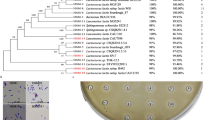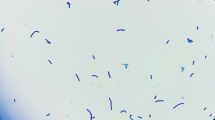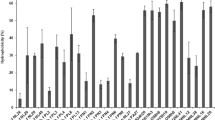Abstract
Probiotic attributes of lactic acid bacteria isolated from goat and sheep milk samples were analysed by culturing them on an MRS agar medium. The most potential isolates, GMB24 and SMB16, were identified by biochemical tests which had ability to tolerate different concentrations of acid and bile and phenol resistance. They were further identified as Enterococcus faecium GMB24 and Enterococcus hirae SMB16 by 16S rRNA gene sequencing approach. The probiotic potential of the isolates GMB24 and SMB16 were recorded including antimicrobial activity against pathogenic bacteria viz., Escherichia coli (MTCC118), Staphylococcus aureus (MTCC7443), Pseudomonas aeruginosa (MTCC424), Listeria monocytogens (MTCC657) and Salmonella typhimurium (MTCC733), and antibiotic susceptibility test. The isolates SMB16 and GMB24 exhibited a higher zone of inhibition against P. aeruginosa (19.00 ± 0.57 mm) and S. aureus (25.66 ± 0.88 mm), respectively. The data from these experiments were used for the principal component analysis (PCA) to assess the survivability of the isolates under different factors. The heatmap generated in this study clustered the bacterial isolates based on their phenotype properties. Further, immunomodulating activities of these probiotic bacteria were tested on neutrophil adhesion test, haemagglutinating antibody titer and delayed-type hypersensitivity. Probiotic E. faecium GMB24 and E. hirae SMB16, at 109 cells/mL doses per day, increased the neutrophil adhesion, haemagglutinating antibody titer and DTH in comparison to the untreated control group. The isolates showed negative test for haemolytic and gelatinase activities and hence were considered safe. E. faecium GMB24 and E. hirae SMB16 were shown to have high probiotic potential and immune-stimulant action.



Similar content being viewed by others
References
Adebayo-tayo BC, Onilude AA (2008) Screening of lactic acid bacteria strains isolated from some Nigerian fermented foods for EPS production. World Appl Sci J 4(5):741–747
Balthazar CF, Pimentel TC, Ferrão LL, Almada CN, Santillo A, Albenzio M, Cruz AG (2017) Sheep milk: physicochemical characteristics and relevance for functional food development. Compr Rev Food Sci Food Saf 16(2):247–262
Blanter M, Gouwy M, Struyf S (2021) Studying neutrophil function in vitro: cell models and environmental factors. J Inflamm Res 14:141–162
Bodera P, Chcialowski A (2009) Immunomodulatory effect of probiotic bacteria. Recent Pat Inflamm Allergy Drug Discov 3(1):58–64
Câmara SPA, Dapkevicius A, Silva CCG, Malcata FX, Enes Dapkevicius LNM (2020) Artisanal Pico cheese as reservoir of Enterococcus species possessing virulence and antibiotic resistance properties: implications for food safety. Food Biotechnol 34(1):25–41
Devaux CA, Million M, Raoult D (2020) The butyrogenic and lactic bacteria of the gut microbiota determine the outcome of allogenic hematopoietic cell transplant. Front Microbiol 11(1642):1–21
Dunislawska A, Herosimczyk A, Lepczynski A, Slama P, Slawinska A, Bednarczyk M, Siwek M (2021) Molecular response in intestinal and immune tissues to in ovo administration of inulin and the combination of inulin and Lactobacillus lactis subsp. cremoris. Front Vet Sci 7:1–9
Erickson KL, Hubbard NE (2000) Probiotic immunomodulation in health and disease. J Nutr 130(2):403–409
FAO W (2001) Evaluation of allergenicity of genetically modified foods: report of a joint FAO/WHO expert consultation on allergenicity of foods derived from biotechnology. FAO, Rome
FAO/WHO (2002) Guideline for the evaluation of probiotics in food: report of a joint FAO/WHO working group on drafting guideline for the evaluation of probiotics in food. (London, Ontario, Canada). Food Res Int 54(1):118–124
Ferreira DS, da Silva J, López Mal D, AnceskiBataglion G, Nogueira Eberlin M, Machado Ronconi C, Alves Júnior S, de Sá GF (2015) Adsorption in a fixed-bed column and stability of the antibiotic oxytetracycline supported on Zn (II)-[2-methylimidazolate] frameworks in aqueous media. PLoS One 10(6):1–20
Gea-Banacloche JC (2006) Immunomodulation. Principles of molecular medicine. Humana Press, Totowa, pp 893–904
Geeta ASY, Pradhan S, Rajoria R, Kumar A, Gopi M, Navani NK, Pathania R (2021) Probiotic attributes of Lactobacillus fermentumNKN51 isolated from Yak cottage cheese and the impact of its feeding on growth, immunity, caecal microbiology and jejunal histology in the starter phase of broiler birds. Indian J Anim Res 55(4):451–456
Ghule BV, Murugananthan G, Nakhat PD, Yeole PG (2006) Immunostimulant effects of Capparis zeylanica Linn. Leave J Ethnopharmacol 108(2):311–315
Graham K, Stack H, Rea R (2020) Safety, beneficial and technological properties of enterococci for use in functional food applications–a review. Crit Rev Food Sci Nutr 60(22):3836–3861
Gupta A, Tiwari SK (2014) Probiotic potential of Lactobacillus plantarum LD1 isolated from batter of dosa, a south Indian fermented food. Probiotics Antimicrob Proteins 6(2):73–81
Hoque MZ, Akter F, Hossain KM, Rahman MSM, Billah MM, Islam KMD (2010) Isolation, identification and analysis of probiotic properties of Lactobacillus spp. from selective regional yoghurts. World J Dairy Food Sci 5(1):39–46
Huang Y, Adams MC (2004) In vitro assessment of the upper gastrointestinal tolerance of potential probiotic dairy propionibacteria. Int J Food Microbiol 91(3):253–260
Metsalu T, Vilo J (2015) ClustVis: a web tool for visualizing clustering of multivariate data using principal component analysis and heatmap. Nucleic Acids Res 43(1):566–570
Mishra S, Acharya S (2021) A brief overview on probiotics: the health friendly microbes. Biomed Pharmacol J 14(4):1869–1880
National Committee for Clinical Laboratory Standard NCCL (1993). Performance standards for antimicrobial disc susceptibility tests Approved Standard M2-A5, 5th Edn. Villanova
Nowak B, Śróttek M, Ciszek-Lenda M, Skałkowska A, Gamian A, Górska S, Marcinkiewicz J (2020) Exopolysaccharide from Lactobacillus rhamnosus KL37 inhibits T cell-dependent immune response in mice. Arch Immunol the Exp 68:1–11
Nwobodo DC, Ugwu MC (2020) Immunomodulatory potentials of probiotics: a review. Asian J Immunol 3:1–15
Otieno DO (2010) Synthesis of β−galactooligosaccharides from lactose using microbial β-galactosidases. Compr Rev Food Sci Food Saf 9(5):471–482
Pieniz S, Andreazza R, Anghinoni T, Camargo F, Brandelli A (2014) Probiotic potential, antimicrobial and antioxidant activities of Enterococcus durans strain LAB18s. Food Control 37:251–256
Pinto MGV, Franz CM, Schillinger U, Holzapfel WH (2006) Lactobacillus spp. within vitro probiotic properties from human faeces and traditional fermented products. Int. J. Food Microbial 109(3):205–214
Pundir RK, Rana S, Kashyap N, Kaur A (2013) Probiotic potential of lactic acid bacteria isolated from food samples: an in vitro study. J Appl Pharm Sci 3(3):85–93
Rajoka MSR, Mehwish HM, Kitazawa H, Barba FJ, Berthelot L, Umair M, Zhao L (2022) Techno-functional properties and immunomodulatory potential of exopolysaccharide from Lactiplantibacillus plantarum MM89 isolated from human breast milk. Food Chem 377:131954
Rajput K, Dubey RC (2020) Probiotic potential and safety characterization of Enterococcus hirae G24 isolated from indigenous raw goat milk. Int J Pharm Sci Drug Res 12(3):1–9
Rajput K, Dubey RC (2021) In vitro antioxidant and in vivo antidiabetic activity of two potential probiotic enterococcus spp. on alloxan-induced diabetic rats. Asian J Pharm Clin Res 14(3):94–98
Sambrook J, Russell DW (2001) Molecular Cloning-Sambrook and Russel-Vol. 1, 2, 3. Cold Springs Harb Lab Press, Long Island, NY, USA
Silva R, Voiry D, Chhowalla M, Asefa T (2013) Efficient metal-free electrocatalysts for oxygen reduction: polyaniline-derived N-and O-doped mesoporous carbons. J Am Chem Soc 135(21):7823–7826
Singh MP, Ahirwar J, Muthal N (2011) Evaluation of immunomodulatory activity of aqueous extract of Ficus bengalensis aerial roots in wistar rats. Asian J Pharm Clin Res 4(1):82–86
Soni M, Shah HR, Patel SM (2021) Isolation, identification and analysis of probiotic characteristics of Lactobacillus spp. from Regional Yoghurts from Surendranagar district, Gujarat. Asian J Dairy Food Res. 40(3):267–272
Stadlbauer V, Mookerjee RP, Hodges S, Wright GA, Davies NA, Jalan R (2008) Effect of probiotic treatment on deranged neutrophil function and cytokine responses in patients with compensated alcoholic cirrhosis. J Hepatol 48(6):945–951
Tambekar DH, Bhutada SA (2010) An evaluation of probiotic potential of Lactobacillus sp. from milk of domestic animals and commercial available probiotic preparations in prevention of enteric bacterial infections. Recent Res. Sci. Technol. 2(10):82–88
Wang CY, Lin PR, Ng CC, Shyu YT (2010) Probiotic properties of Lactobacillus strains isolated from the feces of breast-fed infants and Taiwanese pickled cabbage. Anaerobe 16(6):578–585
Willey JM, Sherwood L, Woolverton CJ (2008) Prescott, Harley, and Klein’s microbiology. McGraw-Hill Higher Education, New York
Xie G, Schepetkin IA, Quinn MT (2007) Immunomodulatory activity of acidic polysaccharides isolated from Tanacetum vulgare L. Int Immunopharmacol 7(13):1639–1650
Yan Y, Wanshun L, Baoqin H, Changhong W, Chenwei F, Bing L, Liehuan C (2007) The antioxidative and immunostimulating properties of D-glucosamine. Int Immunopharmacol 7(1):29–35
Yuksekdag ZN, Aslim B (2010) Assessment of potential probiotic-and starter properties of Pediococcus spp. isolated from Turkish-type fermented sausages (sucuk). J Microbiol Biotechnol 20(1):161–168
Zhou HC, Long JR, Yaghi OM (2012) Introduction to metal–organic frameworks. Chem Rev 112(2):673–767
Acknowledgements
The authors thank the Head of the Department of Botany and Microbiology for providing laboratory facilities and the Head of the Department of Pharmaceutical Science for providing animal house facilities.
Funding
The authors have not disclosed any funding.
Author information
Authors and Affiliations
Corresponding author
Ethics declarations
Conflict of interest
There is no conflict of interest.
Additional information
Communicated by Erko Stackebrandt.
Publisher's Note
Springer Nature remains neutral with regard to jurisdictional claims in published maps and institutional affiliations.
Supplementary Information
Below is the link to the electronic supplementary material.
Rights and permissions
Springer Nature or its licensor holds exclusive rights to this article under a publishing agreement with the author(s) or other rightsholder(s); author self-archiving of the accepted manuscript version of this article is solely governed by the terms of such publishing agreement and applicable law.
About this article
Cite this article
Rajput, K., Dubey, R.C. & Kumar, A. Probiotic potential and immunomodulatory properties in Enterococcus faecium GMB24 and Enterococcus hirae SMB16 isolated from goat and sheep milk. Arch Microbiol 204, 619 (2022). https://doi.org/10.1007/s00203-022-03217-w
Received:
Revised:
Accepted:
Published:
DOI: https://doi.org/10.1007/s00203-022-03217-w




